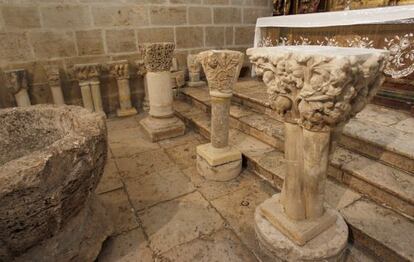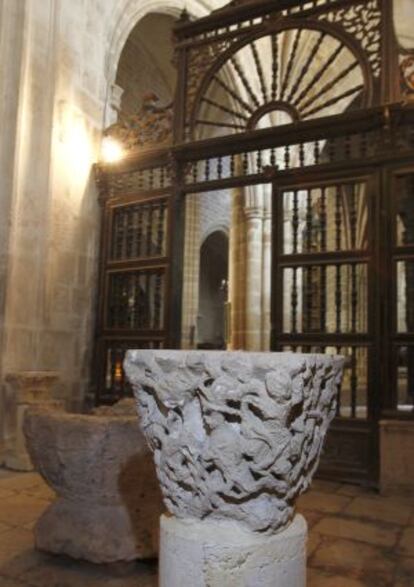Five clues, one true Romanesque gem
Experts suggest candidate sites for the original home of the Palomós cloister


It was shrouded in almost complete secrecy, and now it has its own entry on Wikipedia. Such is life, such is journalism, such is real estate, and no doubt about it, such is the incommensurate power of Romanesque art as a magnet of mystery and enchantment.
The art world was thrown into disarray two weeks ago, when EL PAÍS picked up on the detective-like research of a university professor named Gerardo Boto after he had announced the existence of a hitherto unknown and truly spectacular Romanesque cloister sitting inside a private estate called Mas del Vent, located in Palamós, Girona province. Boto likened the stone gallery to the one in Santo Domingo de Silos, one of Spain's most outstanding examples of Romanesque art.
The find has encouraged all kinds of experts, scholars and interested individuals to speculate as to its place of origin. So far, the cloister has been thought to belong to several churches, monasteries, castles and archeology sites in the region of Castilla y León, more specifically in the provinces of Burgos, Segovia and Palencia. Gumiel de Izán, Castrojeriz, Ibeas, Collado Hermoso and Carrión de los Condes are, for the moment, the most quoted locations by those who know the most about the matter.
José Ignacio Sánchez Rivera of Valladolid University, Félix Palomero Aragón of Rey Juan Carlos University in Madrid and René Jesús Payo Hernanz of Burgos University hold that the stone arches might belong to the Burgos monastery of San Pedro de Gumiel de Izán, which no longer stands; José Luis Hernando of Zamora Museum sees resemblances between the capitals of the Palamós columns and those of the belfry at the parish church in Hontoria de Valdearados (Burgos) as well as remains found at places near Silos, such as Caleruega, Brazacorta, Sepúlveda and Santa María de Retuerta.
But a woman named Saturnina Gómez is convinced that the cloister used to be in her own village, Hortigüela, also in Burgos province, and that it was part of the monastery of San Pedro de Arlanza - "torn down in the early 20th century to make a reservoir that was never built." And so she phoned the newsroom to explain all about it. Meanwhile, the scholar who told the world about Palamós - Gerardo Boto of Girona University - has his own list of possible places of origin for the cloister, whose earliest known location was Madrid in the 1930s.
SAN PEDRO DE GUMIEL DE IZÁN (Burgos)

A Benedictine monastery belonging to the Cistercian house of Morimond in 1194 under the aegis of King Alphonse VIII. Almost no elements from it have been preserved, save for a wall along the perimeter. The parish church of Gumiel de Izán conserves around 10 Romanesque capitals that are said to come, among other places, from the monastic cloister. The morphology of the most Silos-like capitals could really belong to the front of a chapter room, such as the one inside the cathedral at El Burgo de Osma. From the beginning, Professor Boto explored the likelihood of this monastery being the one. Lately Boto has had documentary help from a lawyer named Heri García de Lázaro, who is working on site. But to gain a deeper understanding of this long-gone monastery, it would be necessary to conduct an archeological dig.
CONVENT OF SAN ANTÓN (Castrojeriz, Burgos)
This monastery at the foot of the Camino de Santiago, the pilgrimage route to the holy city of Santiago de Compostela, was built and founded in the 12th century, although the ruins of its church are late Gothic in style. It was a palace and an orchard for King Pedro I of Castille. Some of the rooms underwent severe reform work in later years. The cloister area is still pending an archeological exploration to shed some light on its past. It is unknown whether the dimensions of the stone galleries in Mas del Vent conform to the size of this area. For over a century the convent has been owned by the same family.
SAN AGUSTÍN DE BENEVÍVERE (Carrión de los Condes, Palencia)
All we know about this magnificent canonical work is an engraving by Jenaro Pérez Villa-Amil and a drawing by José María Quadrado, both from the 19th century. The lithograph shows an excellent façade in the chapter room, with seven arches occupied by nearly life-size figures. The galleries were reformed around the 16th century using Salamanca-type arches, which have a 60-degree angle, and the Romanesque capitals were inserted underneath. These pieces closely resemble some of the capitals at Palamós and share with them a late Romanesque cultural style.
SAN CRISTÓBAL DE IBEAS (Ibeas, Burgos)
Monastery of the Norbertine order of which very few remains are known: there is only an ink drawing and one free-standing capital - apparently from the cloister area - that we know of thanks to Maria Teresa López de Gereño, a professor at Autónoma University, who published information about it after recovering it from one of the homes in the village.
SANTA MARÍA DE LA SIERRA (Collado Hermoso, Segovia)
The monastery was founded in the 1130s. Back then, Santa María de la Sierra experienced a monumental expansion. Late in the 12th century it joined the Cistercian order. For the moment it is not possible to either confirm nor reject a relationship with the cloister of Palamós. It is important to remain prudent until the results of an archeological dig taking place there are published.
Tu suscripción se está usando en otro dispositivo
¿Quieres añadir otro usuario a tu suscripción?
Si continúas leyendo en este dispositivo, no se podrá leer en el otro.
FlechaTu suscripción se está usando en otro dispositivo y solo puedes acceder a EL PAÍS desde un dispositivo a la vez.
Si quieres compartir tu cuenta, cambia tu suscripción a la modalidad Premium, así podrás añadir otro usuario. Cada uno accederá con su propia cuenta de email, lo que os permitirá personalizar vuestra experiencia en EL PAÍS.
¿Tienes una suscripción de empresa? Accede aquí para contratar más cuentas.
En el caso de no saber quién está usando tu cuenta, te recomendamos cambiar tu contraseña aquí.
Si decides continuar compartiendo tu cuenta, este mensaje se mostrará en tu dispositivo y en el de la otra persona que está usando tu cuenta de forma indefinida, afectando a tu experiencia de lectura. Puedes consultar aquí los términos y condiciones de la suscripción digital.
Últimas noticias
Magnets in their heads: How some animals guide themselves using the Earth’s magnetic field
From Hungary’s Orbán to Chile’s Kast: How Trump helps turbo charge the far right
From Andorra to Gibraltar, a black market for Ozempic exploits its success: ‘They’re the most sought-after products in the world’
From safe-haven investment to geostrategic weapon: Who owns the most gold and where are the bars kept?
Most viewed
- Why we lost the habit of sleeping in two segments and how that changed our sense of time
- Trump’s obsession with putting his name on everything is unprecedented in the United States
- Charles Dubouloz, mountaineering star, retires at 36 with a farewell tour inspired by Walter Bonatti
- Venezuela faces its most tense Christmas yet
- CBS in crisis after pulling a report on Trump’s deportations to El Salvador (which later leaked online)








































